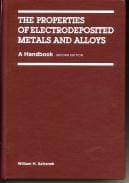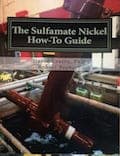
-----
Nickel plating stainless steel springs for conducting electricity
Q. Hello,
We are looking for info on nickel plating SS springs (a flat strip) to lower the electrical resistance. It is used to conduct 9 to 12 Volts of a battery. Can you give us info on procedures: plating or clad? Layer thickness, and other aspects?
Thank you very much in advance,
ing. Jannes Hovius
Industrial design engineer at Electronic Quality Systems B.V.
Jannes HoviusEQS B.V. - Zoetermeer, The Netherlands
1998
by William Safranek

on eBay or Amazon
or AbeBooks
(affil link)
A. Hello Jannes. The conductivity of electroplated nickel is about 20 percent of silver, which does make it substantially better than stainless steel. But you would need to know the current draw and acceptable voltage drop in order to calculate the required thickness of plating to carry the current. Detailed values for resistivity of electroplated nickel are in Safranek's "Properties of Electrodeposited Metals and Alloys" ⇨ More likely, though, is concern about the surface conductivity/resistance of stainless steel because it's a high resistance surface and it's probably common to electroplate it with nickel to address that problem. The process probably needs to start with a Wood's Nickel Strike for good adhesion, and be followed either with electrolytic nickel or electroless nickel plating.

Ted Mooney, P.E.
Striving to live Aloha
finishing.com - Pine Beach, New Jersey
Ted is available for instant help
or longer-term assistance.
Q. Hello
I want to know what is the process of electroplating on stainless steel and its composition.
- Rewari haryana India
October 19, 2015
A. Hi Anil. It is difficult to plate onto stainless steel because, for proper adhesion, we must plate onto metal, not onto oxidized or passive metal, and stainless steel forms an oxidation layer immediately. The usual answer is a Wood's Nickel Strike, which is a dilute plating solution very high in hydrochloric acid, so we can simultaneously dissolve the oxide while depositing a fresh layer of metal. You can search the site for detailed discussions of Wood's Nickel Strike including a couple of versions of the ideal composition.
There are other variations on the same idea, including a sulfamate nickel strike, and some proprietary processes which might be called "stainless activators".
Once the nickel strike is on the stainless, you can plate it with almost any plateable metal or alloy, but you must do so immediately, as the nickel layer will also passivate rather quickly. Good luck.
Regards,

Ted Mooney, P.E. RET
Striving to live Aloha
finishing.com - Pine Beach, New Jersey
Ted is available for instant help
or longer-term assistance.
October 2015
Q, A, or Comment on THIS thread -or- Start a NEW Thread
